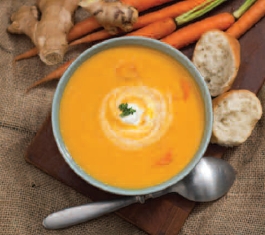According to the 2013 WholeFoods Retailer Survey, prepared foods are a key driver of foot traffic and sales in many natural products stores. Prepared foods—such as ready-made meals, fresh juice from a juice bar, bakery items and the like—comprised about 13.13% of overall sales among independent natural products retailers. Without a doubt, shoppers are drawn to stores that have fresh, delicious prepared foods that can make for a quick, healthy meal.
This month, our Gourmet Guru is Courtney Jo Schoenbaechler, brand marketing manager at Kettle Cuisine of Chelsea, MA. Kettle Cuisine manufactures and sells frozen and refrigerated gourmet soups to food service operators.
WholeFoods: In your opinion, what are the main differences between a run-of-the-mill prepared foods section and a gourmet prepared foods section?

|
|
| Courtney Jo Schoenbaechler |
Schoenbaechler: Great prepared foods sections not only offer a wide variety of foods, but they also rotate offerings frequently and add seasonal limited-time selections. To graduate to the gourmet category, I think the offerings need to be more premium for the refined palate or adventurous eater—which can be accomplished through high-quality ingredients, non-traditional world cuisine or, more simply, a rich and truthful story of the item. Consumers are increasingly eager to know the source and story behind their food—and are willing to pay more for it—especially when shopping in a gourmet environment.
Presentation is also a key trait of good gourmet prepared foods sections. People eat with their eyes first, so displays of fresh leafy salads are appealing, but dry, cold meats are not. It’s important to keep everything in the section as fresh as possible and not overly packaged so that the customer perceives the foods to be the same or better than homemade.
Gourmet prepared foods sections should create an enjoyable shopping “experience” in which the shopper is encouraged to meander, discover what’s new and see, taste and smell their options.
WholeFoods: Where does natural/organic fit in?
Schoenbaechler: Natural and organic consumers tend to be a bit more adventurous with their palates, so to suit their needs, I think retailers should be offering ethnic flavors to balance out the traditional comfort foods. The story behind the ingredients is even more important with natural and organic consumers, who really want to be educated about their food.
WholeFoods: Shoppers seeking out prepared foods at retail stores often want meals that are easy, fresh, delicious, unique and reasonably priced. How can retailers with small-to-medium prepared food sections accommodate these diverse needs?
Schoenbaechler: First, know your audience. When you have limited space, you need to get the most out of every shelf, so make sure you’re giving shoppers what they want and not what you think they should want. Be sure to ask them what they like and what they don’t—from packaging to the mix of items to value. Most people are happy to share their opinions and may become more loyal because you asked.

|
|
| Soups are an important part of a goumet prepared foods section. Photo of carrot-ginger soup, courtesy of Kettle Cuisine. |
Next, rotate often. You will always want to keep the staples on your shelves, but rotating your offerings on a regular basis allows you to discover which products your customers are actually willing to pay for and encourages your customers to keep coming back to see what is new in your prepared food section. It also gives you the opportunity to share a wide selection, even if it’s on a short-term rotating basis.
Last, pick a specialty. There is such a wide variety of consumer preferences in this category—from comforting to adventurous, healthy to indulgent, vegetarian to bacon-laden—so instead of trying to please everyone, try to specialize in a certain type of offering like global flavors or healthy options so your prepared foods section can become a destination for shoppers. Then, you can supplement with other choices to round out your offerings.
WholeFoods: So, you feel the best strategy for prepared foods isn’t offering just a standard menu or having a daily menu; it’s offering a mix of the two?
Schoenbaechler: Because consumers tend to shop at the same store regularly, it’s important to offer a mix of standard and rotating menu items. They are expecting to see certain staples and are counting on those items for their meals, but that doesn’t mean they aren’t willing to try something new if it is offered. The majority of the menu should be standardized so you can build loyalty with your guests, and roughly 25% of the menu should change on a weekly or monthly basis. That way, your guests can feel a sense of choice and you gain credibility by offering different options.
WholeFoods: Given your background, which soup varieties would you recommend on the menu of a store that has room for two to three choices per day?
Schoenbaechler: One classic comfort offering like Chicken Noodle, New England Clam Chowder (regionally appropriate) or Broccoli Cheddar. One vegetarian or vegan option such as lentil, a brothy vegetable soup or vegetarian bean chili. And, one adventurous option like Greek Chicken Orzo, Aztec Chili with Ancient Grains or Roasted Corn & Poblano Soup.
WholeFoods: How about soup toppers that can be sold at the same display?
Schoenbaechler: Shredded cheese, individually packed crackers (gluten free, oyster, saltines, etc.), fried onion strings, sweet potato chips, Asiago croutons and toasted almonds.
WholeFoods: Which three flavor trends are currently hot sellers in the natural gourmet soups category?
Schoenbaechler: Chilies, peppers, sriracha and spicy flavors; unique grains like farro, quinoa and flaxseed; and healthier proteins such as chicken (versus beef) meatballs, seafood and lamb. WF
Published in WholeFoods Magazine, January 2014










